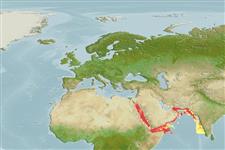Elasmobranchii (haaien en roggen) (sharks and rays) >
Carcharhiniformes (Ground sharks) >
Triakidae (Houndsharks) > Galeorhininae
Etymology: Iago: Name of villain in Shakespeare’s Othello, because members of this genus have been a “troublemaker for systematists and hence a kind of villain”. (See ETYFish); omanensis: -ensis, Latin suffix denoting place: Gulf of Oman, type locality. (See ETYFish).
More on author: Norman.
Environment: milieu / climate zone / depth range / distribution range
Ecologie
marien bathydemersaal; diepte 110 - 2195 m (Ref. 244). Deep-water; 30°N - 10°N
Western Indian Ocean: Red Sea, Gulf of Aqaba (Ref. 9942) and Gulf of Oman to Pakistan and southwestern India. A low-finned, somewhat short-headed Iago is largely sympatric with Iago omanensis at least off southwestern India, and in the Bay of Bengal there is possibly a dwarf, omanensis-like Iago that may or may not be distinct.
Lengte bij maturiteit / Grootte / Gewicht / Leeftijd
Maturity: Lm 55.7 range ? - ? cm
Max length : 37.0 cm TL mannelijk / geslacht onbekend; (Ref. 244); 58.0 cm TL (female)
Korte beschrijving
Determinatiesleutels | Morfologie | Morfometrie
Brown or grey dorsally, lighter below; dorsal and caudal fins may have darker tips and leading edges (Ref. 5485).
Found on the continental shelf and slope. Water temperature: 16-25°C. Oxygen level: 0.2-2.4 ppm. Feeds on bony fishes (mostly lanternfishes) and cephalopods. Sexual dimorphism by size exists. Viviparous (with a yolk-sac placenta), with probably 2 to 10 young in a litter. Utilized fresh for human consumption.
Viviparous, placental (Ref. 50449). Distinct pairing with embrace (Ref. 205).
Compagno, L.J.V., 1984. FAO Species Catalogue. Vol. 4. Sharks of the world. An annotated and illustrated catalogue of shark species known to date. Part 2 - Carcharhiniformes. FAO Fish. Synop. 125(4/2):251-655. Rome: FAO. (Ref. 244)
Status op de Rode Lijst van het IUCN (Ref. 130435)
Gevaar voor de mens
Harmless
Gebruik door de mens
Visserij: visserij voor eigen gebruik
Tools
Speciale rapporten
Download XML
Internetbronnen
Estimates based on models
Preferred temperature (Ref.
123201): 10 - 21.7, mean 14.6 °C (based on 100 cells).
Fylogenetische diversiteitsindex (Ref.
82804): PD
50 = 0.7500 [Uniqueness, from 0.5 = low to 2.0 = high].
Bayesian length-weight: a=0.00427 (0.00183 - 0.00992), b=3.04 (2.83 - 3.25), in cm total length, based on LWR estimates for this (Sub)family-body shape (Ref.
93245).
Trofisch niveau (Ref.
69278): 4.2 ±0.3 se; based on diet studies.
Weerstandsvermogen (Ref.
120179): Zeer laag, minimale populatieverdubbelingstijd meer dan 14 jaar (K=0.48; Fec=2).
Fishing Vulnerability (Ref.
59153): Moderate vulnerability (43 of 100).
